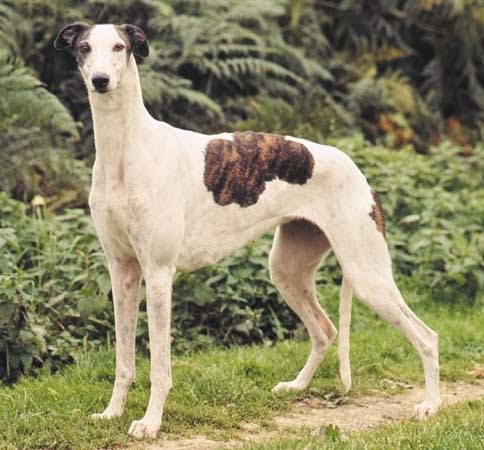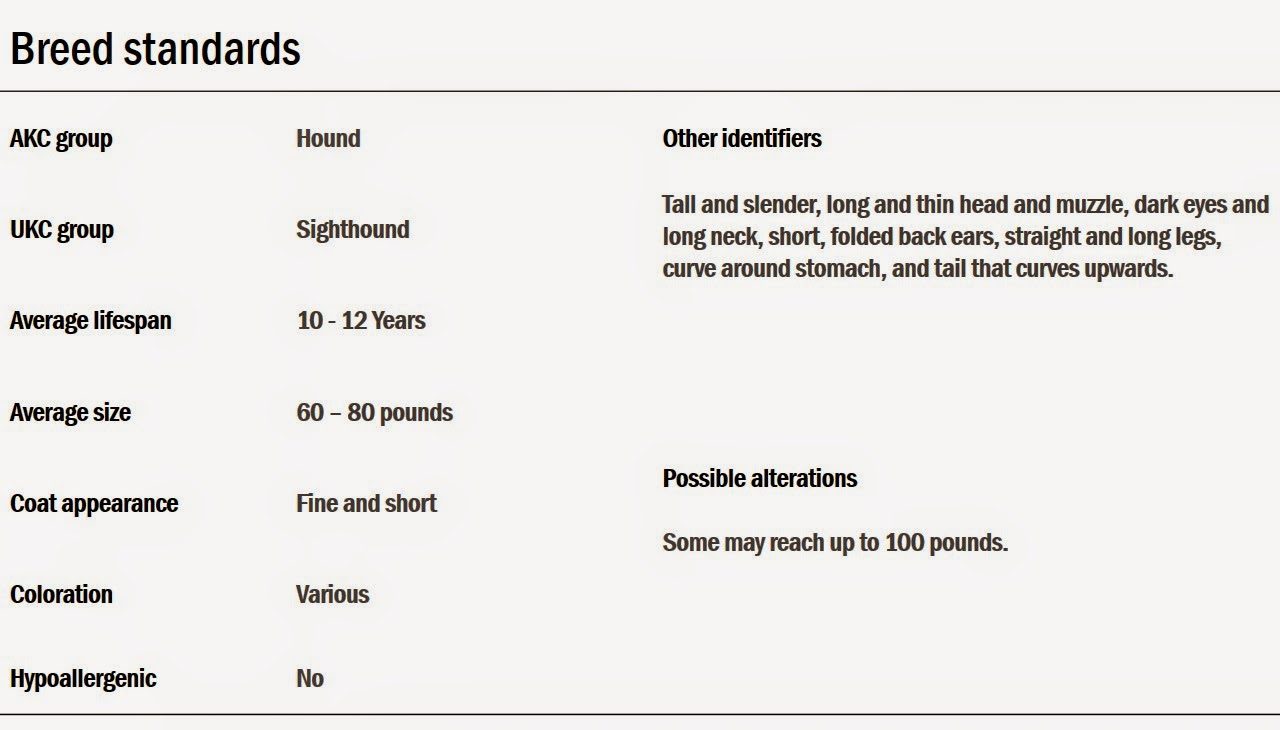Everything about your Greyhound
Nicknamed the 40-mph-couch potato, Greyhounds are quiet, gentle, affectionate dogs who can fit into almost any home. They love a cushy sofa and they are satisfied with a 20-minute walk.
Greyhounds were originally bred as hunting dogs to chase hare, foxes, and deer. Canines in this dog breed can reach speeds of 40 to 45 miles per hour, making them the Ferraris of the dog world. Not surprisingly, Greyhounds made a name for themselves as racing dogs and are still used in racing today. They also participate in many other dog sports, including lure coursing, conformation, obedience, and agility. Beyond their grace and speed, people love them for their sweet, mild nature.
Overview
Whether or not you’ve seen one in the flesh, you know what a Greyhound looks like. The iconic hound with the aerodynamic build epitomizes speed with his narrow head, long legs, and muscular rear end. We’ve all seen images of this sprinter, if only through seeing it plastered on the side of a bus, but many of us don’t truly know the breed.
One of the most ancient of breeds, Greyhounds probably originated in Egypt and have been prized throughout history. Historic figures who were captivated by this breed include Cleopatra, Queen Elizabeth I of England, and General Custer, who raced his dogs the day before he set off on his fateful trip to Little Big Horn. The patronage of the two queens led to Greyhound racing being dubbed the “Sport of Queens.”
Aside from its royal fans, there’s a lot to love about the breed. The Greyhound combines a stately appearance with a friendly attitude toward people and other dogs. Loyal and affectionate with his family, he’s not aggressive toward strangers, although he will let you know — through a bark or a subtle pricking of his small, folded ears — that someone’s approaching your home.
Greyhounds have a reputation for high energy levels, but in reality their favorite pastime is sleeping. Designed as sprinters, not distance runners, they’ll be satisfied with a daily walk, although active people find they make good jogging or running partners. In fact, Greyhounds do fine in apartments or homes with small yards-although they need a solid fence to keep them from chasing animals they might see as prey, such as squirrels, rabbits, or trespassing cats.
Regardless of their strong prey drive, there’s no doubt that this is a wonderful breed that deserves many belly rubs. Whether you bought your Greyhound from a show breeder or adopted him from the racetrack, you’ll find yourself regarding this breed with the same respect that others have given it throughout its long and glorious history.
Other Quick Facts
- The Greyhound has a long, narrow head; small ears; dark eyes; a long, muscular neck that is slightly arched; a broad, muscular back; a deep chest; a long, fine, tapering tail; and a short, smooth coat that can be any color or pattern.
- Greyhounds are the fastest of the dog breeds. They have been clocked at 44 miles per hour, which along with their restful attitude has earned them the nickname “40-mph couch potato.”
- President Rutherford B. Hayes, in office from 1877 to 1881, kept several dogs in the White House, including a Greyhound named Grim.
- Comparable Breeds: Borzoi, Saluki
The name “Greyhound” is generally believed to come from the Old English grighund. “Hund” is the antecedent of the modern “hound”, but the meaning of “grig” is undetermined, other than in reference to dogs in Old English and Old Norse. Its origin does not appear to have any common root with the modern word “grey” for color, and indeed the Greyhound is seen with a wide variety of coat colors. The lighter colors, patch-like markings and white appeared in the breed that was once ordinarily grey in color. The Greyhound is the only dog mentioned by name in the Bible; many versions, including the King James version, name the Greyhound as one of the “four things stately” in the Proverbs. However, some newer biblical translations, including The New International Version, have changed this to strutting rooster, which appears to be an alternative translation of the Hebrew term mothen zarzir. But also the Douay–Rheims Bible translation from the late 4th-century Latin Vulgate into English translates “a cock”.
Personality
They’re intelligent and independent, even catlike in many ways. They do have a sensitive side and are quick to react to tensions in the home. They can become shy or timid with mistreatment, even if it’s unintentional. Temperament is affected by a number of factors, including heredity, training, and socialization. Puppies with nice temperaments are curious and playful, willing to approach people and be held by them. Choose the middle-of-the-road puppy, not the one who’s beating up his littermates or the one who’s hiding in the corner.
Health
The Greyhound, which has an average lifespan of 10 to 13 years, is not prone to any major health problems. However, some of the minor ailments that can affect the breed include osteosarcoma, esophageal achalasia, and gastric torsion. Both the AKC and NGA Greyhounds cannot tolerate barbiturate anesthesia and are susceptible to tail-tip injuries and lacerations, while retired NGA Greyhounds are prone to racing injuries like muscle, toe, and hock injuries.
The Greyhound will do okay in an apartment if it gets enough exercise. It is relatively inactive indoors and a small yard will do. Greyhounds are sensitive to the cold but do well in cold climates as long as they wear a coat outside. Do not let this dog off the leash unless in a safe area. They have a strong chase instinct and if they spot an animal such as a rabbit they just might take off. They are so fast you will not be able to catch them.
Greyhounds that are kept as pets should have regular opportunities to run free on open ground in a safe area, as well as daily long, brisk walks, where the dog is made to heel beside or behind the person holding the lead. In a dog’s mind the leader leads the way and that leader needs to be the human. Greyhounds love a regular routine.
Care
Regular exercise in the form of an occasional run and a long walk on leash is good for the Greyhound. It loves to chase and run at great speeds outdoors, so it should be only let out in safe, open areas. The breed also requires warm and soft bedding and does not like living outdoors. It is easy to maintain its coat – just an occasional brushing to get rid of dead hair.
Grooming
Greyhounds have a short, smooth coat that is simple to groom. Brush it weekly with a hound mitt or rubber curry brush to remove dead hair and distribute skin oils that keep the coat shiny. Greyhounds shed, but regular brushing will help keep the hair off your floor, furniture, and clothing. Bathe as needed. If you do a good job of brushing your Greyhound, he probably won’t need a bath very often.
The rest is basic care. Trim the nails as needed, usually every few weeks. Be aware that Greyhounds are especially sensitive about having their feet handled and nails trimmed. Do your best not to cut into the quick, the vein that feeds the nail. It’s painful and your Greyhound will remember next time and put up a fight. It’s also important to brush the teeth frequently for good overall health and fresh breath. Greyhounds – track dogs in particular – are known for developing periodontal disease, so brushing and annual veterinary cleanings can help keep dental disease at bay.
Is this breed right for you?
A reserved and quiet breed, the Greyhound feels comfortable living in a quiet home. Not a good playmate for younger children, this dog will do better with older children or as an only pet. Known to chase anything that runs, including cats, these pups are only good with felines if trained. OK for apartment living if regularly exercised, the Greyhound does best living indoors with a small yard for playtime.
Children and other pets
Greyhounds can be patient with children and have been known to step delicately around toddlers, but they do best in homes with older children who know how to act around dogs. They’re more likely to walk away from a teasing child than to snap at him.
As with every breed, you should always teach children how to approach and touch dogs, and always supervise any interactions between dogs and young children to prevent any biting or ear or tail pulling on the part of either party. Teach your child never to approach any dog while he’s eating or sleeping or to try to take the dog’s food away. No dog, no matter how friendly, should ever be left unsupervised with a child.
Although Greyhounds do very well with other dogs, they can view smaller dogs, cats, or other small pets as prey, especially if the animals run from them. Some have a much lower prey drive than others, but it’s always best to supervise your Greyhound around smaller animals. Instinct can overcome training, and Greyhounds have been known to injure or even kill smaller pets.
And even if they’re best friends with your indoor cat, they may view outdoor cats that come onto their property as fair game.
Did You Know?
A description written in 1486 is a poetic notion of just how a Greyhound should look: “A Greyhound should be headed like a snake and necked like a drake, backed like a beam, sided like a bream, footed like a cat and tailed like a rat.”
A dream day in the life of a Greyhound
Prone to bloat, the Greyhound does best with breakfast, lunch and dinner. Lazily waking up in the morning to a rubdown, he’ll enjoy sticking to his routine of a morning walk before his owner leaves for work. Enjoying having the house to himself, he’ll lazily keep an eye on everything while you’re away. Greeting you when you come in the door, he’ll be ready for a run and perhaps a bit of racing before the day is over. Just make sure to keep him on the leash in case he spots a rabbit and feels the need to chase it down.








